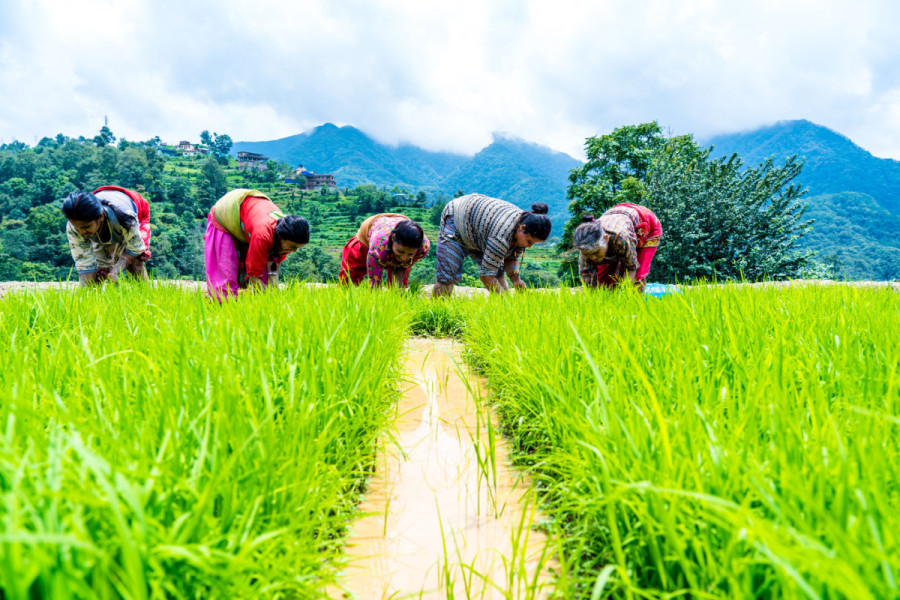Columns
Irrigation for rural development
Small-scale farmers can diversify their crops and improve yields through better irrigation.
Tikaram Adhikari & Nirman Shrestha
The agricultural sector plays a pivotal role in Nepal, serving as the primary source of income for approximately 66 percent of the population and contributing to around 23.95 percent of the country’s overall gross domestic product. However, prevailing poverty demands strategic solutions and irrigation techniques, particularly those aligned with the sustainable intensification of mixed farming systems (SI-MFS), an important tool for promoting sustainable water resource utilisation. Irrigation holds immense potential to increase agricultural acreage and productivity, enabling multiple cropping and protecting farmers from erratic rainfall. Its role in ensuring food security, rural development and poverty alleviation cannot be overstated.
Limited access
While irrigation systems currently support around 40 percent of Nepal’s agricultural land, only 19 percent have access to year-round irrigation. The global challenge of water scarcity is equally relevant in Nepal, affecting more than half of the world’s population for at least one month annually. Despite the country receiving enough rain to water 5 million hectares of land, only a small portion is covered by irrigation systems. Nepal heavily relies on monsoon rainfall (June to September), leading to unpredictable and extreme weather patterns, including floods and droughts, which reduce agricultural productivity. Most agricultural lands are left fallow during the post- and pre-monsoon season, except for a few areas with irrigation facilities, causing significant crop productivity loss.
The Government of Nepal has proposed an ambitious plan to extend irrigated agricultural lands in response to rising food demand. The Agriculture Development Strategy (ADS) for 2015-35 has precise targets for obtaining year-round irrigation. The goal is to achieve 60 percent irrigation coverage by 2025 and 80 percent by 2030. Currently, 2,254 surface water irrigation systems are in place, irrigating about 728,447 hectares of agricultural land. The rivulets and springs in Nepal provide tremendous opportunities for developing smaller irrigation and water distribution systems, especially in water-scarce rural areas.
Reducing poverty
Nepal is struggling with a poverty rate of 21.6 percent—a complex issue that manifests differently across social categories, geographic regions and rural and urban areas. The high unemployment rate and the scarcity of employment opportunities are the leading causes of poverty in Nepal, further exacerbated by political upheaval and energy shortages. Developing efficient irrigation facilities and water management is essential for reducing poverty since many depend on agriculture. By providing year-round irrigation, farmers can cultivate crops throughout the year. This expands cropping area and intensity, reducing dependence on traditional rice-wheat-maize farming systems, leading to improved crop production and higher yields.
Irrigation-driven higher crop yields contribute to increased food supply, aligning with the rule of demand and supply to lower consumer food prices. With increased purchasing power, both farmers and consumers can generate higher income. Moreover, irrigation fosters agricultural diversity and reduces the risk of crop failure due to seasonal impacts or uncontrollable causes. As food production rises, critical food items become more accessible to the populace, resulting in improved food security and greater resilience during times of scarcity.
Irrigation helps increase farm productivity of regular and high-value crops, leading to the involvement of value chain activities like storing, packaging, processing, grading and so on from producers to consumers. This activity provides employment opportunities to market value chain actors, including wholesalers, retailers, input suppliers, etc. Furthermore, constructing infrastructure such as canals, roads, and electricity linked with irrigation creates new job possibilities, contributing to poverty alleviation. Enhanced livelihoods translate into improved family health and education as households have more resources to invest in these critical areas. Moreover, reduced poverty alleviates the country’s debt burden, fostering economic growth and stability.
Further benefits
What’s more, irrigation offers significant advantages to impoverished communities through increased agricultural output, higher crop yields, reduced risks of crop failure, and a steady year-round availability of farm and non-farm employment opportunities. Small-scale farmers can diversify their crops and shift from low-value subsistence farming to more profitable market-oriented production. This transition to a market-based economy helps integrate the poor into various markets related to land, labour, commodities and information, empowering them in the process. The augmented production of crops ensures a stable supply of food, which becomes more affordable and accessible to the poor. The primary beneficiaries of this situation are the poor and landless, as they rely on purchasing food and benefit from lower food prices. Similarly, indirect benefits such as infrastructure development for health services, roads and the lowering of indebtedness can be achieved through the multiplier effects of irrigation development.
To reiterate, irrigation plays a vital role in poverty reduction, and its successful development necessitates careful planning, environmentally responsible water management and active community participation. Additionally, good governance, access to credit, training programmes and technical support are crucial for ensuring the long-term success of irrigation projects and driving rural development.




 16.12°C Kathmandu
16.12°C Kathmandu
















